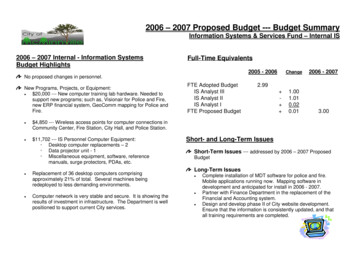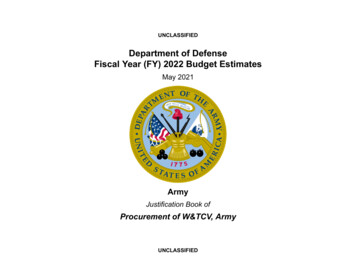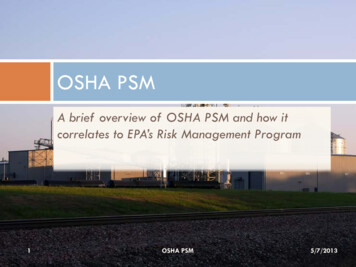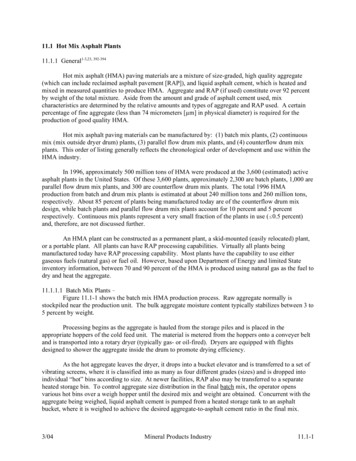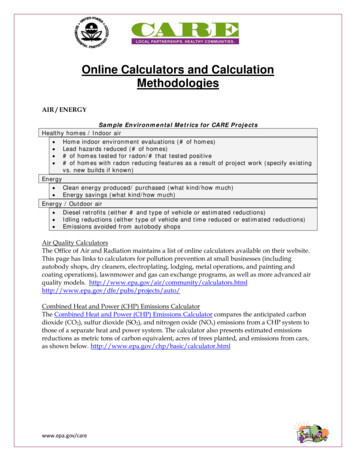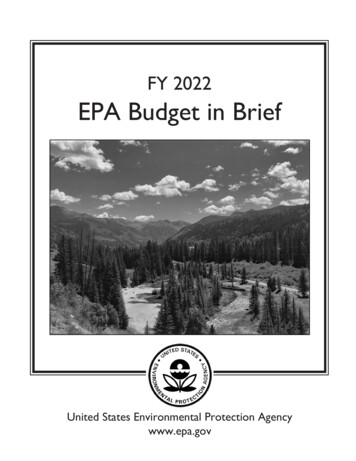
Transcription
FY 2022EPA Budget in BriefUnited States Environmental Protection Agencywww.epa.gov
United States Environmental Protection AgencyOffice of the Chief Financial Officer (2710A)Publication Number: EPA-190-R-21-003May 2021www.epa.govCover Photo Submission: Gabrielle Schluter – Uncompahgre National Forest, ColoradoReprinted May 26, 2021
FY 2022 EPA Budget in BriefTable of ContentsPAGEForward.1Budget Overview .3Summary Resource ChartsEPA’s Budget by Appropriation .19EPA’s Resource History .21EPA’s Resources by Major Category.23AppendicesProgram Projects by Program Area.27EPA’s Resources by Appropriation.37Categorical Program Grants.39Categorical Grants Overview.41Estimated SRF Obligations by State (FY 2020 – FY 2022) .49Infrastructure Financing.53Trust Funds.59Programs Proposed for Elimination.63Highlight of Major Program Changes .65List of Acronyms.73
Usage and TerminologyUsage and TerminologyThe FY 2022 EPA Budget in Brief displays funding in columns marked as FY 2020 Actuals, FY2021 Enacted Budget, FY 2022 President’s Budget, and the FY 2022 President’s Budget versusthe FY 2021 Enacted Budget. FY 2020 levels exclude the Coronavirus Aid, Relief, andEconomic Security Act unless otherwise stated and FY 2021 levels exclude the AmericanRescue Plan Act of 2021 amounts. Amounts in the FY 2020 Actuals column reflect directfinancial obligations as reported by the Governmentwide Treasury Account Symbol (GTAS)system. Fixed costs refer primarily to costs that are largely unavoidable in the short term (e.g.pay increases, General Services Administration set rent costs, utilities and security costs,unemployment compensation, and government-wide changes in health benefits).Please note that amounts presented reflect budget authority unless otherwise specified. Numbersin tables and graphs may not add to totals because of rounding.1
2
OverviewUnited States Environmental Protection AgencyFY 2022 Budget OverviewThe United States Environmental Protection Agency (EPA) is guided by a clear and vital mission:to protect human health and the environment. While the Agency has made great progress inadvancing this mission over the last fifty years, much work remains to guarantee that all Americansshare in the benefits of clean air, clean water, and safe communities and are protected from theurgent threats posed by climate change while creating good paying jobs. The FY 2022 President’sBudget for the EPA confronts these challenges with the largest top-line request in the Agency’shistory and emphasizes four cross-cutting priorities: Tackling the Climate Crisis through Science,Advancing Environmental Justice, Supporting State, Tribal and Local Partners, and Expanding theCapacity of EPA.The FY 2022 Budget request for the EPA provides 11.2 billion and 15,324 FTE to expand thecapacity of EPA to safeguard human health and the environment for all communities. In today’sdollars, the FY 2022 Budget returns EPA to similar levels from FY 2010 and the early 2000s. TheBudget includes more than 1,000 new EPA FTE to address the Agency’s priorities and work withour partners across the Nation to make a real difference in the lives of all Americans by meetingtoday’s environmental challenges and preparing for tomorrow’s. The FY 2022 Budgetcomplements the transformational investments in the American Jobs Plan. The American JobsPlan would address aging water infrastructure, replace all lead pipes and service lines in ourdrinking water systems, electrify 20 percent of our yellow school bus fleet, invest in monitoringand remediating PFAS (per- and polyfluoroalkyl substances) in drinking water, and accelerate theremediation and cleanup of contaminated land. The FY 2022 Budget and American Jobs Planleverage existing programs at the EPA to improve the environmental and public health challengesfacing our Nation, while creating good paying jobs to rebuild America’s infrastructure and supportU.S. manufacturing.The FY 2022 Budget request allocates 1.8 billion to tackle the climate crisis and directs half ofthis investment toward advancing environmental justice. This investment recognizes that policiesto tackle climate change must also clean up the legacy pollution that low-income communities andcommunities of color have suffered with for far too long. In the process of tackling the climatecrisis there is a historic opportunity to make our communities more resilient to climate impacts,advance environmental justice, and create good paying jobs. The FY 2022 Budget commits toensuring these communities benefit from the country’s transition to a cleaner economy and moreclimate-resilient infrastructure.The Agency is currently developing the new FY 2022 – 2026 EPA Strategic Plan to be issued inFebruary 2022, which will establish a new framework- rooted in a commitment to science,adherence to the law, and environmental justice- to guide the Agency’s priorities and progress.The plan will include the strategic goals, objectives, four-year long-term performance goals, andtwo-year agency priority goals that tether resource investments and strategies to the outcomes thatwill better protect human health and the environment.3
OverviewFY 2022 Funding PrioritiesTackling the Climate CrisisThe FY 2022 Budget reprioritizes addressing climate change with the urgency the sciencedemands. EPA’s recently relaunched Climate Change Indicators website presents compelling andclear evidence of changes to our climate reflected in rising temperatures, ocean acidity, sea levelrise, river flooding, droughts, heat waves, and wildfires. The Budget includes an increase of 1.8billion in programs to tackle the climate crisis while also delivering environmental justice tomarginalized and over-burdened communities, investing in local economies, and creating goodpaying jobs.For FY 2022, EPA requests a 100 million increase for air quality grants to states and tribes tohelp expand the efforts of air pollution control agencies to implement their programs and accelerateimmediate on-the-ground efforts to reduce greenhouse gases. Every American deserves to knowtheir exposure to air pollution. Toward that goal, and in concert with Section 222 of the ExecutiveOrder on Tackling the Climate Crisis at Home and Abroad, the Budget invests 100 million todevelop a community air quality monitoring and notification system to provide real-time data tooverburdened and marginalized communities and enforcement officials. By maximizing thetransparency of air pollution levels at the community scale, we can better ensure that places withthe most significant exposure are being targeted for action and measurable progress.The FY 2022 Budget includes an additional 60 million to conduct research and deepen ourknowledge of the impacts of climate change on human health and the environment. Thisinvestment more than doubles EPA’s climate change research while providing additionalinvestments to decrease emissions of methane and hydrofluorocarbons. Half of this increase willfund collaborative research in climate adaption and resilience with the new Advanced ResearchProjects Agency for Climate (ARPA-C) that will be located within the Department of Energy. TheBudget also includes additional investments to decrease emissions of methane andhydrofluorocarbons (HFCs). The Agency is working to implement Executive Order 13990 onProtecting Public Health and the Environment and Restoring Science to Tackle the Climate Crisis.In FY 2022, EPA will ensure that policy is guided by the best science and is protected by processesthat encourage integrity in the Agency’s decision-making.Both climate mitigation and adaptation are essential components of the strategy to reduce thethreats and impacts of climate change. The FY 2022 Budget will enable EPA to address the climatecrisis while creating good paying jobs in four key ways: adapting to the impacts of climate changethrough infrastructure investment; mitigating climate change by reducing greenhouse gasemissions; expanding our climate research and policy development; and partnering with the globalcommunity to respond to this shared challenge.Adapting to Climate Impacts through Infrastructure InvestmentUpgrading and adapting America’s infrastructure to meet the demands of the changing climate iscritical to keeping communities healthy and safe. As the climate warms, more extreme rainfall and4
Overviewflooding events can damage or overwhelm water systems, leaving entire communities without safewater supplies for days or weeks. Flooding events also can disturb and circulate dangerouspollution from Superfund toxic waste sites, making remediation of these sites a priority for publichealth in a warming world.In the FY 2022 Budget, EPA proposes a 589 million increase in several existing waterinfrastructure programs, including the Clean Water State Revolving Funds (CWSRF), DrinkingWater State Revolving Funds (DWSRF), the Water Infrastructure Finance and Innovation Act(WIFIA) program, and grant programs authorized in the America’s Water Infrastructure Act of2018 (AWIA) and the Water Infrastructure Improvements for the Nation Act of 2016 (WIIN).Together, these financing programs will advance the Agency’s ongoing commitment toinfrastructure repair and replacement and build climate resilience into the water sector. At the sametime, these investments will create hundreds of thousands of good-paying jobs across the country.1EPA estimates that the country needs to invest more than 743 billion over the next 20 years tomaintain, upgrade, and replace critical drinking water and wastewater infrastructure.2 Today, upto 10 million homes in America and more than 400,000 schools and childcare centers rely on leaddistribution lines—a clear and present danger to the health of children. EPA’s State RevolvingFund (SRF) programs help states, municipalities, and other eligible borrowers to finance highpriority investments that improve water quality and protect human health. The FY 2022 Budgetprovides 3.2 billion across the two SRF programs, a 464 million increase above the FY 2021enacted levels, representing nearly 30 percent of EPA’s total resource request.The FY 2022 Budget includes 1.871 billion for the CWSRF program, a 232 million increaseabove the FY 2021 enacted level. The CWSRF program capitalizes state revolving loan funds inall 50 states and Puerto Rico to finance infrastructure improvements for public wastewater systemsand projects to improve water quality. It represents the largest source of federal funds for states toprovide loans and other forms of assistance for water quality projects including construction ofwastewater treatment facilities, water and energy efficiency projects, and green infrastructureprojects. In addition to capitalizing the CWSRF Program, a portion of the request will providedirect grants to communities in tribal nations and territories. The sanitation infrastructure in thesecommunities often lags the rest of the country, causing significant public health concerns.EPA’s DWSRF is designed to assist public water systems in financing the costs of drinking waterinfrastructure improvements needed to achieve or maintain compliance with Safe Drinking WaterAct (SDWA) requirements, to protect public health, and to support state and local efforts to protectdrinking water. The FY 2022 Budget requests 1.358 billion for the DWSRF, a 232 millionincrease, to help finance critical infrastructure improvements to public drinking water systems.States have considerable flexibility to tailor their DWSRF program to their unique circumstancesand needs, allowing each state to carefully and strategically consider how best to achieve the1Jobs Created estimates are based on the U.S. Water Alliance: The Value of Water Campaign: The EconomicBenefits of Investing in Water Infrastructure.2For more information on EPA’s Clean Water and Drinking Water Needs Survey Reports, visit:https://www.epa.gov/cwns and infrastructure-needs-surveyand-assessment5
Overviewmaximum public health protection and infrastructure development that benefits all Americans andis resilient to the impacts of climate change.The WIFIA program, created in 2014, is a critical tool to accelerate water infrastructureinvestments by leveraging public and private sources of funds to maximize the reach of federalfunds. As of May 2021, the WIFIA program had issued 50 loans to communities across the countrytotaling more than 9 billion in credit assistance to help finance nearly 20 billion for waterinfrastructure projects. WIFIA loans for these projects have saved communities more than 4billion, which they will use to accelerate additional infrastructure investment and keep ratesaffordable for water system users. These WIFIA financed projects support 49,000 jobs and servemore than 31 million people, demonstrating that WIFIA credit assistance is an effective tool tohelp address a variety of water infrastructure needs to support all manner of communitiesnationwide. The FY 2022 request expands the WIFIA credit subsidy by 12.6 million, whichwould enable EPA to provide up to 8 billion in direct credit assistance and help spur more than 16 billion in total infrastructure investments.A parallel goal of infrastructure repair and replacement is to advance Agency efforts in addressinglead and other contaminants in drinking water, especially in small and underserved communities.AWIA strengthened many existing programs within EPA, including programs authorized by theWater Infrastructure Improvements for the Nation (WIIN) Act, while creating new programs totackle significant public health and environmental concerns. The FY 2022 request expands theprogrammatic capacity to support small and disadvantaged communities, to reduce lead in drinkingwater, to provide lead testing in schools, to expand sewer overflow control grants, and to builddrinking water resilience. In total, the FY 2022 Budget provides 249.4 million in funding for theAWIA and WIIN grant programs.Many communities also face the challenge of cleaning up contaminated lands so that they can beredeveloped and reused. The FY 2022 request enables the Agency to expedite the cleanup ofhazardous waste sites that litter communities across the country, particularly low-incomecommunities and communities of color. Of the total funding requested for Superfund, 1.108billion and 1,261 FTE would support Superfund cleanup programs, a 299.4 million increase overlast year. The cleanup programs include Superfund Remedial, Emergency Response and Removal,EPA Emergency Preparedness, and Federal Facilities programs. Federal data in a recentGovernment Accountability Office (GAO) report suggests that approximately 60 percent ofSuperfund sites overseen by EPA are in areas that are vulnerable to wildfires and different typesof flooding—natural hazards that climate change will exacerbate.3 The Agency is working to cleanup these sites with climate change in mind to protect the populations most at risk of toxic chemicalexposure, including children, the elderly, and low-income communities.Tackling the Climate Crisis through Pollution ReductionCutting the pollution that causes climate change not only benefits the climate but also offersvaluable co-benefits for human health. Long-term exposure to elevated levels of certain airpollutants has been associated with increased risk of cancer, premature mortality, and damage tothe immune, neurological, reproductive, cardiovascular, and respiratory systems, while short-term3https://www.gao.gov/products/gao-20-736
Overviewexposure can exacerbate asthma and lead to other adverse health effects and economic costs.4 Theissues of highest importance for EPA’s air program over the next decade will continue to bereducing emissions of greenhouse gases (GHG), ozone-forming pollutants and particulate matter,and air toxics. Relying on the latest science, the EPA will work to reduce the sources of thesepollutants from mobile and stationary sources while creating good paying jobs. The FY 2022request leverages several approaches including regulatory tools, innovative market-basedtechniques, public and private-sector partnerships, community-based approaches, voluntaryprograms that promote environmental stewardship, and programs that encourage adoption of costeffective technologies and practices.EPA plays a lead role in implementing a global phasedown in the production and consumption ofhydrofluorocarbons (HFCs). These potent greenhouse gases, which are common in refrigerantsand aerosols, have global warming potentials hundreds to thousands of times larger than carbondioxide. This uniform federal phasedown approach led by EPA will decrease the production andimportation of HFCs in the United States by 85 percent over the next 15 years. As a result, it willhelp promote American leadership in innovation and manufacturing of new climate-safe productsand create new jobs in this emerging sector. A global HFC phasedown is expected to avoid up to0.5 degree Celsius of global warming by 2100.Another EPA effort to reduce GHGs and dangerous air pollution is the Diesel Emissions ReductionAct (DERA) grant program. The FY 2022 request expands this proven grant program by 67percent, or 60 million, to expand the availability of DERA grants and rebates to reduce harmfuldiesel emissions and tackle the climate change crisis, with a focus on priority areas includingschool buses, ports, and disproportionately affected communities. DERA helps remove olderdirtier diesel engines from the roads via retrofits, rebuilds, and replacements; fuel switching andelectrification; and strategies to reduce idling. Pollution emissions from the legacy diesel enginefleet will fall over time as portions of the fleet are replaced with new engines that meet modernemission standards. However, without additional action, the Agency estimates that approximatelyone million old diesel engines will remain in use in 2030.5 These grants accelerate the pace atwhich dirty engines are retired or retrofitted and target resources in areas with poor air quality,especially those with significant emissions from ports and goods movement. These locations alsooften are where lower income communities and communities of color suffer from higher levels ofpollution.Extraction and processing of natural resources, including fossil fuels, biomass, minerals, andmetals, make up approximately 50 percent of the total greenhouse gas emiss
Cover Photo Submission: Gabrielle Schluter – Uncompahgre National Forest, Colorado Reprinted May 26, 2021 . capacity of EPA to safeguard human health and the environment for all communities. In today’s . direct grants to communities in tribal na
